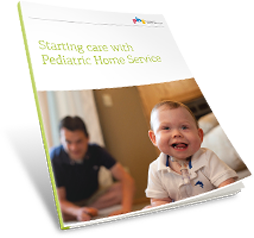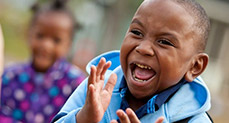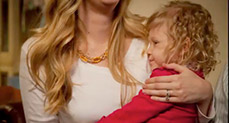Finding Continuity Between Home and Work Life As The Mom of a Medically Complex Child
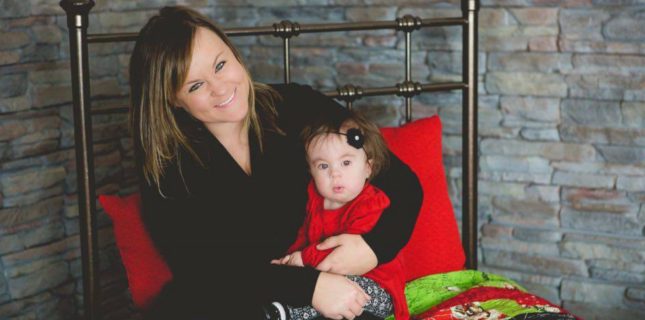
When Molly started at Pediatric Home Service in 2012 as a customer service representative, she expected to help children with medical complexities receive the care and supplies they needed to thrive at home. And that is exactly what she’s done for more than three years. What she didn’t expect was that during this time, she would also come to need these services on a more personal level.
Concerns on an ultrasound
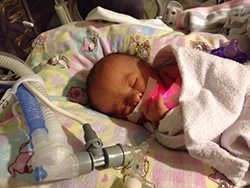 At 20 weeks pregnant, Molly and her husband, Mike, went to a routine ultrasound for a check-up and to learn the gender of their first baby. When the technician called the doctor into the lab, Molly instinctively knew it was regarding her and was soon told that there were some concerning findings in the ultrasound with her baby’s head shape and choroid plexus cysts.
At 20 weeks pregnant, Molly and her husband, Mike, went to a routine ultrasound for a check-up and to learn the gender of their first baby. When the technician called the doctor into the lab, Molly instinctively knew it was regarding her and was soon told that there were some concerning findings in the ultrasound with her baby’s head shape and choroid plexus cysts.
“She said it could be multiple things, or it could be nothing,” said Molly. “So she told us to get a higher level ultrasound. This was on a Friday, and we got in for an appointment the following Tuesday. Waiting those few days was torture. That same night we had a gender reveal party but we didn’t want to mention anything, because we just wanted to celebrate our baby.”
Molly and Mike met with a perinatal specialist, who found cysts that indicate a 1% chance of their baby having Trisomy 18. Molly opted against genetic testing and continued to go in for ultrasounds until she was induced at 38 weeks due to gestational hypertension, polyhydramnios, and fetal growth concerns.
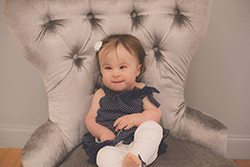 After making no progress following her induction, the doctor broke her water – unexpectedly causing the baby to go into distress. Molly remembers nurses suddenly rushing into the room and transporting her to another area. Molly gave birth to her daughter, Addyson, via C-section within 15 minutes of her water breaking.
After making no progress following her induction, the doctor broke her water – unexpectedly causing the baby to go into distress. Molly remembers nurses suddenly rushing into the room and transporting her to another area. Molly gave birth to her daughter, Addyson, via C-section within 15 minutes of her water breaking.
“When Addyson was born, they brought her over to me for a quick moment, and she was breathing on her own at the time, but they took her to the NICU,” remembered Molly. “After a couple hours in recovery, I was able to go see her.”
By that time, Addyson had been intubated and put on a ventilator after she started to have a hard time breathing during her transport to the NICU.
A better understanding
To a new mother who doesn’t have background on durable medical equipment and infants with complex medical situations, the scenario Molly encountered would be understandably overwhelming and scary.
 “I think because I had experience at PHS, this didn’t really frighten me as much as it did my family,” said Molly. “Throughout my time at PHS and my pregnancy, I talked to multiple families each day who deal with similar situations and live at home with this same equipment. So it was scary, but I knew it would be okay.”
“I think because I had experience at PHS, this didn’t really frighten me as much as it did my family,” said Molly. “Throughout my time at PHS and my pregnancy, I talked to multiple families each day who deal with similar situations and live at home with this same equipment. So it was scary, but I knew it would be okay.”
Having helped dozens of families go home with their child’s equipment and supplies, Molly had the confidence that once Addyson was ready to go home, they would be able to transition easily – complex medical needs and all.
“I remember finding out three days later that Addyson had Trisomy 18, which is generally viewed as incompatible with life in the medical community,” remembers Molly. “But I was determined to bring her home.”
Fighting for her life
After confirming an official diagnosis, Molly and her husband, Mike, were given the option to take Addyson off the vent and let her pass away naturally – a scenario they weren’t willing to consider.
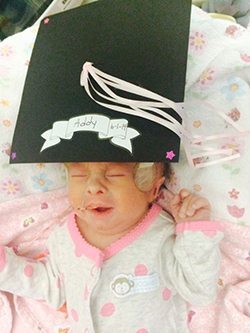 “Before they got the genetic tests back, her levels and sats were fine – so we knew we wanted to give her every opportunity she could have,” added Molly.
“Before they got the genetic tests back, her levels and sats were fine – so we knew we wanted to give her every opportunity she could have,” added Molly.
The first hurdle was undergoing surgery to fix her choanal atresia, or a blockage in the nose. The next day, Addyson was taken off the vent and transitioned to oxygen by cannula – progress that earned her a move from the NICU to the ICC. Nurses urged Molly to go home to recover from her C-section, but she was determined to stay with Addyson.
After having a g-tube placed and managing a seizure scare with medication, Addyson was ready to go home at four weeks old. Again, thanks to her background at PHS, Molly was far less intimidated by the situation and what going home with equipment and daily care meant.
“Our family members were so scared of the whole process, and for me it was just something that happens all the time to people,” remembered Molly.
Defying the odds
Today, Addyson is constantly amazing everyone around her – at 18 months, she has blown away the statistic that children with her diagnosis have only a 10% chance to live to age 1. With supplies from PHS and skilled nursing helping to keep her at home, the family is creating their new normal and enjoying every moment with their stubborn, sweet, feisty daughter.
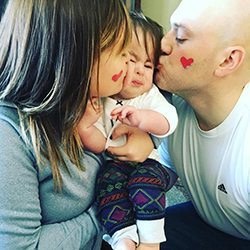 “She’s doing so many things doctors didn’t think she’d do – rolling, speaking baby, working on getting a stander in physical therapy,” gushed Molly. “Every time I bring her into the doctor, they can’t believe it. She’s opening their eyes and proving their prognoses wrong – something I’m so proud of her for.”
“She’s doing so many things doctors didn’t think she’d do – rolling, speaking baby, working on getting a stander in physical therapy,” gushed Molly. “Every time I bring her into the doctor, they can’t believe it. She’s opening their eyes and proving their prognoses wrong – something I’m so proud of her for.”
Molly attributes the fact that she’s been able to stay so positive about the entire situation to her experience working with families and providers of children with complex medical needs – and considers her start at PHS about a year before she got pregnant to be serendipitous.
“You hear about families – a lot of mothers – who get depressed and feel alone,” said Molly. “And I didn’t, I think because I knew it would be okay. I know firsthand that there are other families, and resources, and people to reach out to for support.”
Progress straight ahead
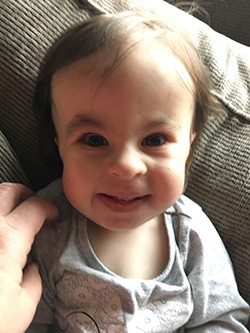 Addyson recently celebrated her year-and-a-half birthday (they celebrate half birthdays along with the yearly), and spends her days doing therapy and giving love to everyone around her.
Addyson recently celebrated her year-and-a-half birthday (they celebrate half birthdays along with the yearly), and spends her days doing therapy and giving love to everyone around her.
Molly’s main focus right now is to keep an eye on Addyson’s heart due to a ventricular septal defect and patent ductus arteriosus – holes that require consistent monitoring.
Addyson’s main focus is continuing to give and receive love from everyone around her – something she can’t get enough of.
“She loves people,” said Molly. “She can have a massive amount of toys in front of her, and not care about any of them – all she wants is for someone to be right in her face, kissing her and talking to her. She loves love.”
Originally published: March 9, 2016
